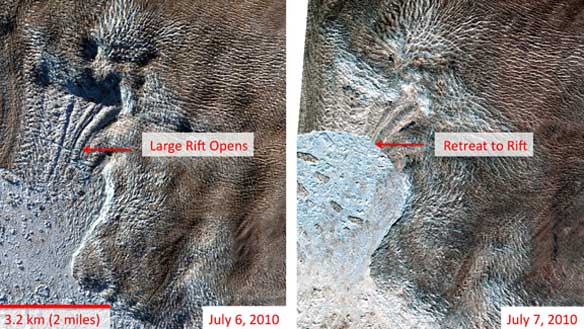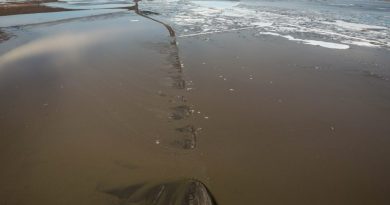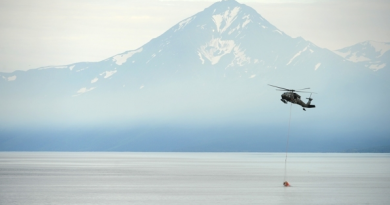Greenland Iceberg Could be Canada-Bound
 A giant chunk of ice that has broken from a glacier off Greenland’s west coast could end up in Canada’s eastern and Arctic waters, presenting potential risks to marine shipping lanes.
A giant chunk of ice that has broken from a glacier off Greenland’s west coast could end up in Canada’s eastern and Arctic waters, presenting potential risks to marine shipping lanes.
An iceberg about seven square kilometres in size — about one-eighth the size of New York’s Manhattan Island — broke off Greenland’s Jakobshavn Isbrae glacier overnight between July 6 and 7, according to NASA-funded researchers.
The ice, which has since fractured into smaller chunks, could drift into marine shipping lanes off Canada’s coasts in the next year, but federal officials say the ice will likely break up even more by then.
“They tend to break up,” Darlene Langlois, manager of forecast operations with Environment Canada, told CBC News on Wednesday. “It’s really rare to get really large icebergs coming down towards Newfoundland. They tend to be smaller pieces, a little bit more manageable size.
“It will take a while for these icebergs to get down to Newfoundland. They usually go up in the current, up to the North first, and then they come down.”
Plenty of time to react
Jim Bruce, an ice engineering director with a company that advises Newfoundland’s offshore oil companies on how to avoid iceberg collisions, agreed that the Jakobshavn Isbrae glacier ice will not likely make it that far south.
Even if the ice chunks do make it into Newfoundland’s waters, agencies will have time to prepare themselves, he said.
“An iceberg that’s a kilometre across, you’ll likely have a year’s knowledge,” Bruce said. “It’ll be spotted much further north. You’ll have plenty of time to react to it.”
At the Canadian Coast Guard station in Iqaluit, officers say they are confident commercial ships will be able to navigate safely in Canadian Arctic waters, even if there are icebergs from the glacier.
“We provide them with all possible information, so they are aware of everything and they have all the information they need,” said Jean-Pierre Lenhert, the commanding officer at the Iqaluit station.
“We do have an airplane that is flying all the time, you know, and looking at the ice conditions, so we can provide the vessel with the recommended ice route.”
Ice to be monitored
Langlois said Environment Canada, through the Canadian Ice Service, is monitoring the movement of the newly broken ice.
“When the iceberg is very large, it’s pretty easy to see on the radar,” she said. “But when they’re small, it can be a real challenge to see them.”
The other problem is when they’re embedded in sea ice — they can be really challenging to see and to pick out.”
The Jakobshavn Isbrae glacier is believed to have been the source of the iceberg that sank the Titanic in 1912.
The glacier’s calving front, where the ice sheet meets the ocean, retreated by nearly 1½ kilometres during the latest breakup.
Warming oceans may be to blame
NASA scientists say the breakup followed a warm winter in which no sea ice formed in the surrounding bay.
“While the exact relationship between these events is being determined, it lends credence to the theory that warming of the oceans is responsible for the ice loss observed throughout Greenland and Antarctica,” Thomas Wagner, a NASA cryospheric program scientist, said in a release.
As much as 10 per cent of all ice lost from Greenland came from the Jakobshavn Isbrae glacier, which scientists believe is largely responsible for rising sea levels in the Northern Hemisphere.
“It’s got the potential to drain a large area of the Greenland ice sheet,” said Ted Scambos, the lead scientist with the National Ice and Snow Data Center in Colorado. “That, of course, has an impact on sea level rise.”
Changes in wind patterns and ocean circulation are bringing warm water to the surface farther north, causing the glacier to retreat faster than any other glacier in Greenland, Scambos said.
“If that’s a trend that’s going to continue, as a result of greenhouse gas effects on the atmosphere, that’s going to accelerate the process that we thought maybe we had some more time to figure out,” he said.
As more of the glacier breaks off, the glacier’s retreat will speed up, which Scambos said will mean more of Greenland’s frozen coastline will disappear.



